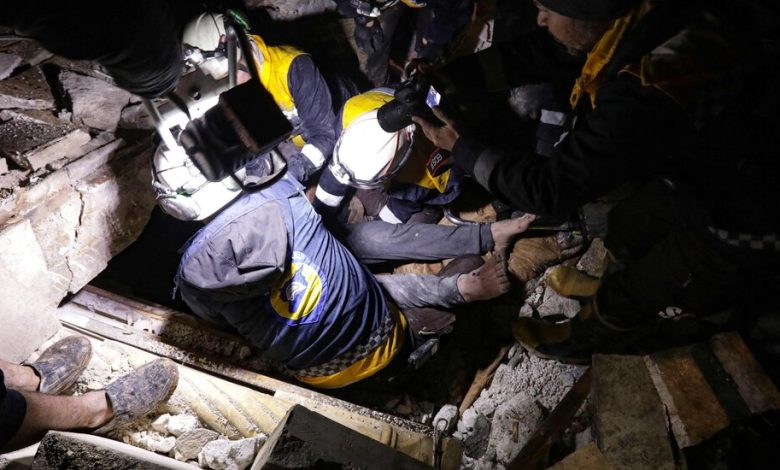For Syrians Who Endured a Brutal Civil War, the Suffering is All Too Familiar

Across northwestern Syria on Monday, apartment blocks, shops, even entire neighborhoods were wiped out in seconds, in scenes that were all too familiar to a region devastated by years of civil war.
“We kept looking up to the sky for jets,” said Osama Salloum, a doctor from Idlib. “My mind was playing tricks on me, telling me it was war again.”
Rescue crews from Idlib to Aleppo to Hama responded immediately but the scale was too much even for a country accustomed to felled buildings. There were not enough machines and rescue tools to cope with the large number of people trapped in debris, and videos posted online showed people using their bare hands to dig through rubble to rescue family and neighbors.
Buildings that were damaged but still standing after the first earthquake collapsed in the aftershocks. Videos posted online showed people running away seconds before structures crumbled in clouds of dust. Witnesses said that even relatively new buildings, hastily constructed, had fallen.
“I’m still hearing buildings are collapsing here and there, old buildings, new ones even,” said Ziad Ubari, who owns a pharmaceutical factory in Aleppo. “Every hour I hear that maybe 40 buildings have fallen in the past hour.”
When the earthquake first struck in the early hours of the morning, the streets of the city were full of terrified residents in their pajamas and underwear in freezing temperatures, he said.
“They just wanted to survive,” he said. “Such terrifying moments.”
In one video, women carried their children on an Aleppo street in thick winter blankets a man yelled repeatedly as first one and then a second building suddenly fell, filling the street with dust. Aerial footage released by the emergency service group known as the White Helmets showed entire rows of buildings flattened into unrecognizable piles of rubble.
Rescuers fought against the cold and rain to dig through the wreckage, and despite cold and rain, told people to evacuate their homes and stay in open areas. Schools opened to shelter people, another echo of their wartime experience.
Scenes from hospitals resembled those from the height of the war, with wards full of patients sharing beds and doctors treating victims in every corner.
Dr. Salloum said he received an urgent call soon after the earthquake, asking him to go to a hospital just outside Idlib, dug deep underground during the war to protect it from airstrikes. The drive took more than twice as long as usual due to debris in the streets.
And his arrival was daunting. “The dead were piled in the halls,” he said, estimating that at least 50 bodies lined the hospital corridors. “Every moment fresh bodies were being brought in, they did not stop. Many of them were children.”
One boy, about 6 years old, died as Mr. Salloum was administering CPR. “I saw the life leave his face,” Dr. Salloum said.
“All the traumatic images from my work during the war flooded back to me,” he added. “I felt like I was waking in a recurring nightmare.”
At a maternity hospital in Idlib, the power failed as seven women were undergoing cesarean deliveries, said the hospital manager, Ikram Habboush.
Mark Kaye, a spokesman for the International Rescue Committee, said that even before the earthquake, the aid group was worried about freezing temperatures this week in Syria and many people’s inability to heat their homes.
“We implore that if countries are sending rescue teams to Turkey that they not forget Syria,” he said.
“Anywhere else in the world this would be an emergency,” he added. “What we have in Syria is an emergency within an emergency.”